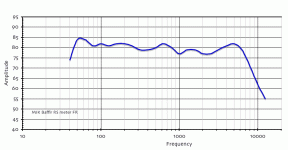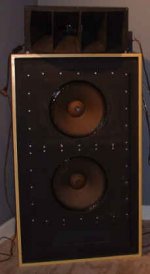Re: freq response measurements
mor2bz said:with the cheapo ratshack analog meter at about 8 ft with
the bass boosted 5 db at aprox. 50 hz. (boost curve unknown)
Attachments
Here are my measurements with some small tweaks to the initial build. I have also measured my B&W Nautilus 804 for comparison. The 804 may have a better curve; but it's absolutely no match to the OB sound to my ears. I'd welcome any suggestions on how to make the MJK OB even better.
Here are the tweaks I've made to the initial built:
- upgraded to FE108EZ
- added a 2" wide "frame" around the back of the baffle
- rounded the baffle edges
- added a 9"x25" triangular wing behind the baffle
- added an L-pad (currently set to max)
Measurements were made with:
- ETF
- Radio Shake digital SPL meter as mic/pre (with the analog SPL meter compensation file on the ETF site)
- EL84 push-pull amp
- Creative MP3+ USB Sound card
Measurement at 1m on axis to the FR :
Measurement at the listening position (approx 4' x 8' off)
Comparison of the above with a B&W Nautilus 804 pointing directly at the listening position.
Here are the tweaks I've made to the initial built:
- upgraded to FE108EZ
- added a 2" wide "frame" around the back of the baffle
- rounded the baffle edges
- added a 9"x25" triangular wing behind the baffle
- added an L-pad (currently set to max)
Measurements were made with:
- ETF
- Radio Shake digital SPL meter as mic/pre (with the analog SPL meter compensation file on the ETF site)
- EL84 push-pull amp
- Creative MP3+ USB Sound card
Measurement at 1m on axis to the FR :
An externally hosted image should be here but it was not working when we last tested it.
Measurement at the listening position (approx 4' x 8' off)
An externally hosted image should be here but it was not working when we last tested it.
Comparison of the above with a B&W Nautilus 804 pointing directly at the listening position.
An externally hosted image should be here but it was not working when we last tested it.
I am obtaining some Eminence Alpha 15A's soon and intend on following the MJK design.
I am just wondering if I should stick to using the FE103E or are there any better alternatives?
I am just wondering if I should stick to using the FE103E or are there any better alternatives?
The FE-103E is the minimum cost driver option. If I were building the design, I would spend a little more and use the FE-108EZ driver. I have not heard the FE-103E so I cannot comment on the performance, I have heard the FE-108EZ and was very impressed.
There are no other changes required to the design, the FE-108EZ is a drop in replacement for the FE-103E assuming that the Fostex spec sheets are accurate.
We are going to give the FF85K a try in this... on its own it is a stellar mid-tweeter. My one fear is that it may not be quite efficient enuff to get away with a passive XO.
dave
dave
Martin,
I've been assuming that your OB sheets are based on a flat, square piece of wood (ie. like it's been cut with a bandsaw) as the baffle. How much effect is there if I decide to 'round' the edges of the baffle for extra SAF points, say a 2" quarter round on top and sides? I'm guessing measurable, but not that noticable...?
I've been assuming that your OB sheets are based on a flat, square piece of wood (ie. like it's been cut with a bandsaw) as the baffle. How much effect is there if I decide to 'round' the edges of the baffle for extra SAF points, say a 2" quarter round on top and sides? I'm guessing measurable, but not that noticable...?
planet10 said:We are going to give the FF85K a try in this... on its own it is a stellar mid-tweeter. My one fear is that it may not be quite efficient enuff to get away with a passive XO.
There are a couple of options.
Since it is a less efficient driver then maybe use a less efficient woofer, smaller diameter might be possible.
Or, use a smaller baffle to cut the bass efficiency of the Alpha 15A.
Or, adjust the crossover to roll the Alpha 15A off sooner.
Maybe add some series resistance and a smaller baffle to get deeper but less efficient bass from the Alpha 15A.
I think there are many more options that could be factored into the design if the FF85K driver were used.
Cloth Ears said:I've been assuming that your OB sheets are based on a flat, square piece of wood (ie. like it's been cut with a bandsaw) as the baffle. How much effect is there if I decide to 'round' the edges of the baffle for extra SAF points, say a 2" quarter round on top and sides? I'm guessing measurable, but not that noticable...?
You assumption about the OB math model is correct. I think your guess about the inpact of the 2" quarter round is also reasonable. My feeling is that the influence of the edge condition on the sound is small compared to room interactions or other variables in your audio set-up.
MJK said:My feeling is that the influence of the edge condition on the sound is small compared to room interactions or other variables in your audio set-up.
Thanks Martin. I feel that while the influence of this small change on the sound will be negligible, the effect on allowing the speakers into the room in the first place - will be immense.
I hope you have a good 2008!
MJK said:There are a couple of options.
Thanx Martin... those are all very good points to think about when designing any OB...
dave
MJK: I really appreciate your article. You tackled a very interesting problem, the article was well written and a joy to read. As a result, I feel a deep obsession to build a pair.
Thanks for the positive feedback, it is greatly appreciated.
I think that OB speakers should be a simple design to get right if you don't ignore the physics of the baffle and the low frequency roll-off it adds.
I see many people picking very efficient midrange and tweeter drivers and then trying to mate them with woofer combinations that are the same efficiency or lower, they then try and equalize to get the bass back. In my opinion they are fighting nature and adding complexity. If you pick the drivers carefully based on relatve SPL (woofer combination 6 to 10 dB more efficient) and with appropriate Qts (woofer Qts>1.0) I think it is an efficient easy design and build in a reasonable sized baffle. If you follow these guidelines either passive or active crossovers can be used, I would make the same recommendations for driver properties regardless of the crossover type. Keep it simple and you increase your chances of success.
I think that OB speakers should be a simple design to get right if you don't ignore the physics of the baffle and the low frequency roll-off it adds.
I see many people picking very efficient midrange and tweeter drivers and then trying to mate them with woofer combinations that are the same efficiency or lower, they then try and equalize to get the bass back. In my opinion they are fighting nature and adding complexity. If you pick the drivers carefully based on relatve SPL (woofer combination 6 to 10 dB more efficient) and with appropriate Qts (woofer Qts>1.0) I think it is an efficient easy design and build in a reasonable sized baffle. If you follow these guidelines either passive or active crossovers can be used, I would make the same recommendations for driver properties regardless of the crossover type. Keep it simple and you increase your chances of success.
Does the type of timber used for the baffle have an impact on the sound? I was thinking of going with a basic cheap marine ply, but would birch ply sound better?
wixy said:Does the type of timber used for the baffle have an impact on the sound? I was thinking of going with a basic cheap marine ply, but would birch ply sound better?
Hopefully the material used for the baffle does not vibrate and contribute anything to the speaker's acoustic performance. My advice would be to make sure your baffle construction is mechanically strong enough and well damped so that it does not add any voice of its own to the recording being reproduced.
Thanks, so perhaps making the baffle very thick would be a good idea? Do you have a recommendation for the baffle thickness? 18mm ply is readily available but is this enough?
Greets!
FYI, in the early days of audio, speaker systems were designed by some of the country's best electrical mechanical engineers money could buy and they chose 1" no-void marine grade plywood framed/braced with full size 2 x 4s for their woofer OBs used to fill in the below the large mid-bass/mids/HF theater horns.
Overkill? Maybe, but I built these 20 ft^3 cabs almost 40 yrs ago with 3/4" no-void marine grade framed/braced with the down sized 1.5 x 3.5" '2x4' stock of the day and can still balance a coin on edge and play 16 Hz - up as loud as most folks can tolerate that aren't stone deaf without it moving, so considering an OB is a lean-to wall, I'm thinking not.
GM
FYI, in the early days of audio, speaker systems were designed by some of the country's best electrical mechanical engineers money could buy and they chose 1" no-void marine grade plywood framed/braced with full size 2 x 4s for their woofer OBs used to fill in the below the large mid-bass/mids/HF theater horns.
Overkill? Maybe, but I built these 20 ft^3 cabs almost 40 yrs ago with 3/4" no-void marine grade framed/braced with the down sized 1.5 x 3.5" '2x4' stock of the day and can still balance a coin on edge and play 16 Hz - up as loud as most folks can tolerate that aren't stone deaf without it moving, so considering an OB is a lean-to wall, I'm thinking not.
GM
Attachments
I have been considering methods for OB construction for my next design. One method that I have spent some time on is using two plywood sheets sandwiching a layer of fiberglass matt, or possibly a soft rubber sheet, about 1/4 of an inch thick. This would apply a damping layer to dissipate any relative motions between the plywood panels. The plywood panels would be joined at only a few locations with screws to compress the center layer. The drivers would only be attached to the front piece of plywood. I used this technique on a large BR box many years ago and it yielded a very dead cabinet. As long as the final composite OB is less than 6 inches thick, the thickness should not impact the performance much.
- Status
- Not open for further replies.
- Home
- Loudspeakers
- Full Range
- New MJK Baffle Article

